Continues from :
What are We Doing?
Roger Bunce
And, of course, if you didn’t manage to put bars and tone on at the beginning, you could always put them on at then end – but upside down.
Pat Heigham
I’ve never seen ‘bars and tone’ upside down (laterally reversed??)
The clapper board went on at the end upside down if missed at the start (provided the camera hadn’t cut, which was the usual case!)
Nick Ware
When you see bars upside down it’s usually ‘cos you’ve had one too many. 😉
John Howell
I’m sure I hadn’t had one too many when I saw a “Bargain Hunt” where they demonstrated an acoustic gramophone. The shot was just long enough to notice the turntable rotating the wrong way.
I suppose there are people today who don’t know what a gramophone is/was – let alone an acoustic one!
Keith Wicks
Interesting. I intend to write to “Radio Times” about this. I’ve noticed it a few times on “Bargain Hunt”, including edition on 4th July 2017, and also on a couple of TV dramas.
It seems to be a matter of economy. They want to open the lid of the gramophone, play a record, then close the lid. But, for the last shot, they simply use part of the first shot played backwards. So they do end up with the lid closed again but, as you have noticed, when we last see the record, it appears to be turning the wrong way (with the groove apparently being dug into by the steel needle).
Has anyone here any experience of working on a programme for which this has been considered acceptable? It is certainly not right for an antiques programme to suggest that records should be played incorrectly. I’ve attached a short clip from the 4th July 2017 programme.
Bargain Hunt – Peterborough (2017-07-04) – gramophoneDave Mundy
Amazingly, it was going the correct way at the start of the clip and the reversed!
Pat Heigham
I was puzzled by John’s tale, and could only assume that the shot had been flipped. Keith’s explanation makes sense, but how stupid!
Did it appear with ‘Nipper’ the HMV dog?
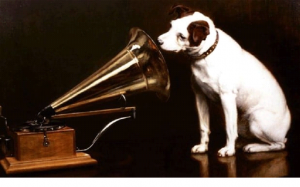
I inherited a Mikiphone, a pocket phonograph, ideal for taking on a river picnic to entertain your popsie whilst rowing or poling along! (Bigger pocket needed for the records).
For scale the record shown is 10″.
(Click on the pictures below to see larger versions:
use your Browser’s BACK button to return to this page)
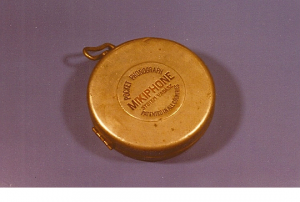
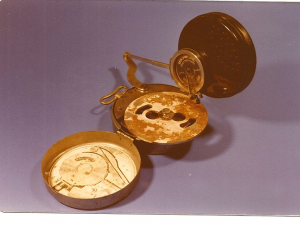
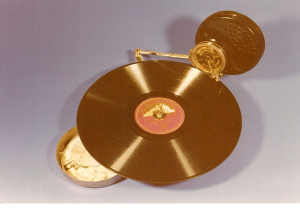
The late Roger Davis – TA behind the scenes at TVC, ran a clock repair business in my village, and renovated the device, fixing the main spring, and making a complete new screw lock for the steel needle. He used steel needles in his repair business for fixing the various ‘sides’ of the mechanisms.
The turntable platter has now been recovered with felt.
I’m hoping that “Antiques Road Show” might come near me, and I can trot along with it!
Gary Critcher, Keith Wicks
One thing I have noticed a couple of times on “Antiques Road Trip” is a shot of the classic car they are on the road with being driven on the wrong side of the road.
They’ve obviously wanted (say) a right-left shot but didn’t have one so have just reversed the one they DO have!
David Buckley
I remember seeing one of many police series documentaries where a shot of a police helicopter had been flipped (rather than reversed).
It was obvious that there was something wrong with the shot, as the choppers ident was back to front, but I wonder how many viewers noticed such detail?
Ian Hillson
….and from the “Guardian” 30th June 2017, discussing the introduction of colour to Wimbledon:
(Click on the picture below to see larger version:
use your Browser’s BACK button to return to this page)
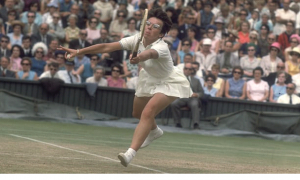
Spot the error in the photo!
[ans: Billie-Jean King was right-handed.]
Tony Crake
The opening Titles of the “Onedin Line” had an Oil Tanker pretty clearly displayed!
(Click on the picture below to see larger version:
use your Browser’s BACK button to return to this page)
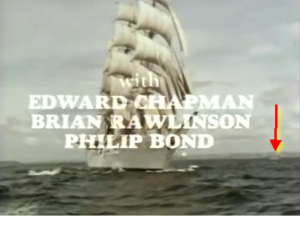
Chris Booth
But there are the ‘specialists’ who notice every detail!
Back in the day (late 1970s), Brian Johnson made a documentary using original WW2 colour film about a raid by Lancasters on Germany. One memorable shot was a take-off at full load which was filmed from an Airspeed Oxford flying at lawnmower level alongside the runway.
It was very long, so a cutaway was inserted – a shot from underneath the pilot looking up to the canopy. This shot consisted of part of the canopy support and lasted a mere three seconds, just enough to let us remove a long chunk of the take off.
Post transmission, quite a few letters were received on the lines of “Why, in the shot of the Lancaster taking off, was there a brief shot of a Halifax Mk III cockpit?”
Sadly I lent my VHS of this to someone and I have never seen it since!
Pat Heigham
A WW2 spy film that I worked on, had a steam train entering a tunnel, engine seen from front. Shot of train exiting tunnel – engine had different number!
With the ability to pause and frame advance of DVD’s, these inaccuracies are more easily spotted!
Peter Combes
Ah. The Prometheus aircraft in David Lean’s “The Sound Barrier”, played by the Vickers 535, had RAF serial VV119 After the Prometheus crashed, the Prometheus II flew — with serial VV119, Wonderful filming, though — shot on infra-red stock, I believe.
Dave Plowman
I well remember watching a cops and robbers feature film, I think with Michael Cain. The robber’s car was nice new Jaguar 3.8 MkII. Which then went over a cliff during a pursuit. But that car was clearly a MkI by the different tail lights, and also a base model as it didn’t have the engine size badge on the back.
My pet hate is WW2 etc dramas where all the cars have two tail lights. One of the few bits of retrospective legislation as regards cars. Even seat belts weren’t a required to be retro fitted, even where this was possible.
Sara Newman
What I find is that all the cars are clean and perfect ! No dirty cars in those days.
John Howell
… and many of them have registration numbers with ‘S’ as the second or third letter because they were unissued Scottish numbers given to vehicle restorers as ‘age related’. The reasoning being that the rate of usage was far slower in Scotland than in England so more numbers were available of the classic form ABC 123.
Ian Hillson
At one point the DVLA were issuing ‘A’ suffix regs as age related (so ABC 123A f’rinstance) as not many were ever issued – your local reg office would still have been using up 123 ABC in the run up in the year that ‘A’ suffix began. Whenever I saw an ‘A’ suffix on the telly it always made me think ‘restored vehicle’ – that is until someone pointed out to the DVLA that they were breaking their own rules, and they stopped doing this!
You’re not allowed to disguise the age of any vehicle by putting a later reg plate on it, and some of those vehicles had been earlier than 1963.
Dave Plowman
There is no reason why a restored vehicle shouldn’t have its original plate, excepting some where it might have been sold off.
When the larger prop car companies (Action Cars, etc) get involved, they usually fit false plates to a vehicle while actually filming. I think they have a selection of numbers cleared with the DVLA for this sort of use.
Owning a ‘classic’ car, I’ve been approached on a few occasions by production companies wanting to use it. But they expect car and driver for less than the equity rate. Sadly many are happy to see their car used for vanity purposes, and do it for what amounts to just expenses.
John Howell
There’s another annoyance I see quite often:
Car arriving home after a long journey, it enters the shot, engine running at enhanced tickover speed, steam and water issuing from its exhaust, and obviously on full choke having been started a couple of minutes ago (it was probably being polished by its proud owner). No-way had it been any sort of journey!
Roger Bunce
Reversed images: – I have just had a rant at a BBC South East Today posting on Facebook – shot portrait format, with fuzzy bits down the sides (Why?) and the whole image is laterally inverted – shop signs etc. are mirror images. Why, Oh Why, Oh Why! (Do smart phones have a ‘reverse-scan’ option, for use as a mirror – like those monitors we used to rig for puppeteers?).
I am now feeling guilty, since it was an item about a very worthy charity – but there are certain principles which should not be compromised!
And here’s my rant to go with it, in case you can’t find it –
====
“…For God’s sake BBC South East Today – if you want to look like a professional broadcaster – turn the camera on its side! – to give a landscape format picture. Then you could dump the ugly, waste-of-space, frosted-glass effect at the sides. And why has everything been laterally inverted? (Check the mirror-image shop signs!) If you’re using the BBC brand name – get it right! It’s not difficult…”
====
Oddly, this version has black at the sides, rather than the frosted glass effect.
Oh! And I’ve just noticed she says, “Very unique.” – will this torment never end?
Chris Woolf
Probably because she’s using the selfie camera. In normal mode that will give a mirror image. On my phone (and I suspect most others) you can tell it to flip the image when stored, to get writing etc correct.
So, either this was a “live” picture, or she hadn’t dived into “settings” and pressed the flip button.
She’s holding the phone in her right hand and filming herself, so she has to use that camera (rather than the rear one) and try (ineffectually) to frame everything as she moves around. But that doesn’t excuse the vertical format…
Peter Neill
It was, indeed, live which explains the flipping. And the orientation is down to Facebook too. If you stream via FB live with your phone in landscape mode, FB will rotate the feed so that everyone is on its side. It has no way of knowing which way you were holding the phone and assumes that it was vertical and (probably correctly) that most viewers are watching the same way.
SE Today did some pre-election discussions where the feed from the broadcast quality sat truck was fed via a laptop to FB. We were even able to add name supers and everything looked fine.
Ian Hillson
In the final frame I noticed a proper tripod in the background – so some professional broadcaster sent a trained cameraperson.
Bill Jenkin
You can now do a Facebook Live from an iPhone (not Android) which is both not flipped if using the selfie camera and either vertical or landscape orientation.
For both Android and iPhone, as long as you have the phone orientated that way before you start the live it will be the way you want it. Also on an iPhone you can change the back camera flipping in a Facebook live setting before you start streaming.
There is an argument for vertical format because that’s the way most people will be watching it on a Smartphone. If they are holding it vertically they will get a letter box picture at the top if frame if shot landscape.
Mike Jordan
I love the reply on that page to Roger’s comments about portrait/landscape. In other words, encourage the punters to use this format so it can also be used full frame if later used on proper TV to save sending a real camera (NOT!)
“…Roger: portrait format is used because that fills up the whole screen on mobile and that’s where the majority of Facebook live viewers are going to be watching so the BBC are absolutely following best practice for the platform that they’re using. With Facebook there is always a compromise with video as to whether you optimise for desktop or mobile but maybe you could have just given your preference rather than “for gods sake…”?
The image is being inverted because it’s using the selfie camera on a phone. There are ways around this but it’s just a quick video while they were there to record the main professional video for TV. Why not enjoy this as an extra bonus, if we get too critical they’ll pull Facebook live and just focus on the TV segment and we’ll all lose out…”
Dave Plowman
I’d guess there’s not a person in the land who hasn’t seen a widescreen TV or been to the cinema. So why it should be the norm to shoot phone footage 90 degrees out must just be down to fashion. The thing most of us only just remember.
On my phone, it is no more difficult to take a pic etc either way round. But then it’s not an I-thingie, so not a fashion statement.
Pat Heigham
… I was startled to see an internal advert for a training(!) course for PA’s and researchers to learn how to operate handheld videocams …
Bernie Newnham
…and I’ve been teaching versions of that course ever since.
Even then it worked both ways – our VT editor on “The Frame”, a 1997 super cheap everyone-does-everything 104 show half hour arts magazine for UK Arena soon became a BBC Arts assistant producer. Our technical producer, who specified the gear, did lots of the training and made a good number of the films was an ex-cameraman (me).
These days most kids go to university to get into tech-ops jobs. It isn’t the right way, but it’s the only way. We teach them everything we can, from how to tell a story to how to set the iris. One week I can be telling a student to go and re-shoot and re-edit their film, and another telling them to crane up a bit.
Everything has changed, and yes, some of it is crap, but then it always was. And anyone who looks back and thinks everyone in tech-ops was a genius is looking back through rose coloured specs. You remember those crews you really didn’t want be on? Panning the viewfinders down over lunch anyone?
These days there are too many students at too many universities paying too much money for very few jobs. I’m pleased that some of ours get proper TV jobs, and those people generally deserve it, but what happens to the others I have no idea. Almost certainly they will end up doing jobs they could have done without going to uni, except they now have a bill of £27,000 round their necks.
Nick Ware
Back in the PD150 days I was quite sceptical about the training Pat mentions, but once the Z1 arrived, and soon after that, the far better Z7, it seemed inevitable that (dare I say?) less demanding material would be shot by trained up researchers, PA’s, etc. And why not?
Over the years I’ve occasionally been called by, and have worked with camerapersons who started that way. In one particular case, there was an assistant with us who normally ‘did’ the sound, but would call someone like me if it was anything more complex than he was comfortable with. I always made a point of making it a learning opportunity for him, and so inevitably the time came when he could tackle whatever the job threw at him, and I got called no more. And that’s fine by me. In the absence of “proper training” I had treated him as an apprentice and let old give way to young.
Back in the days when I taught Sound on the Guildford Art School, Film & TV Course, which later became the West Surrey College of Art & Design, Media Studies Course, I often used to say to students who confidently told me they were destined to be famous directors and/or cameramen: “Well, when you are, don’t forget to call me and I’ll gladly come and work for you!”. On a few occasions that actually happened, and one of them later gave me some of the best paid and most regular work I ever had, over a 16 year period. He’d gone from being a student, to become a camera assistant, and soon after, staff cameraman for CBS “60 Minutes”, where he stayed for 35 years. He’s now retired with a pension that’d make your eyes water. Not bad for no proper training.
One Guildford student, a gorgeous Norwegian girl, on leaving college went travelling around the World, as many did, and used to send me a postcard from whichever country she happened to be in. The last one I got said she was back home in Norway now and had a cutting job, and would I like to come and work with her? I assumed that meant neg cutting as in film editing, and thought: “Well I’ve never done any editing, but Norway is a beautiful temptation, and so definitely is she”. Sadly, in the last sentence she casually let slip that the cutting job wasn’t film at all, but cutting fish! Ah, sweet Vibeke, wherever you are, you could have changed my life!
Geoff Fletcher
Vibeke? Surely not the one in “I am curious yellow”?
Nick Ware
Tee hee, no. 1967 a bit too early. ( but I did do an IMDb check, just to be sure. ).



